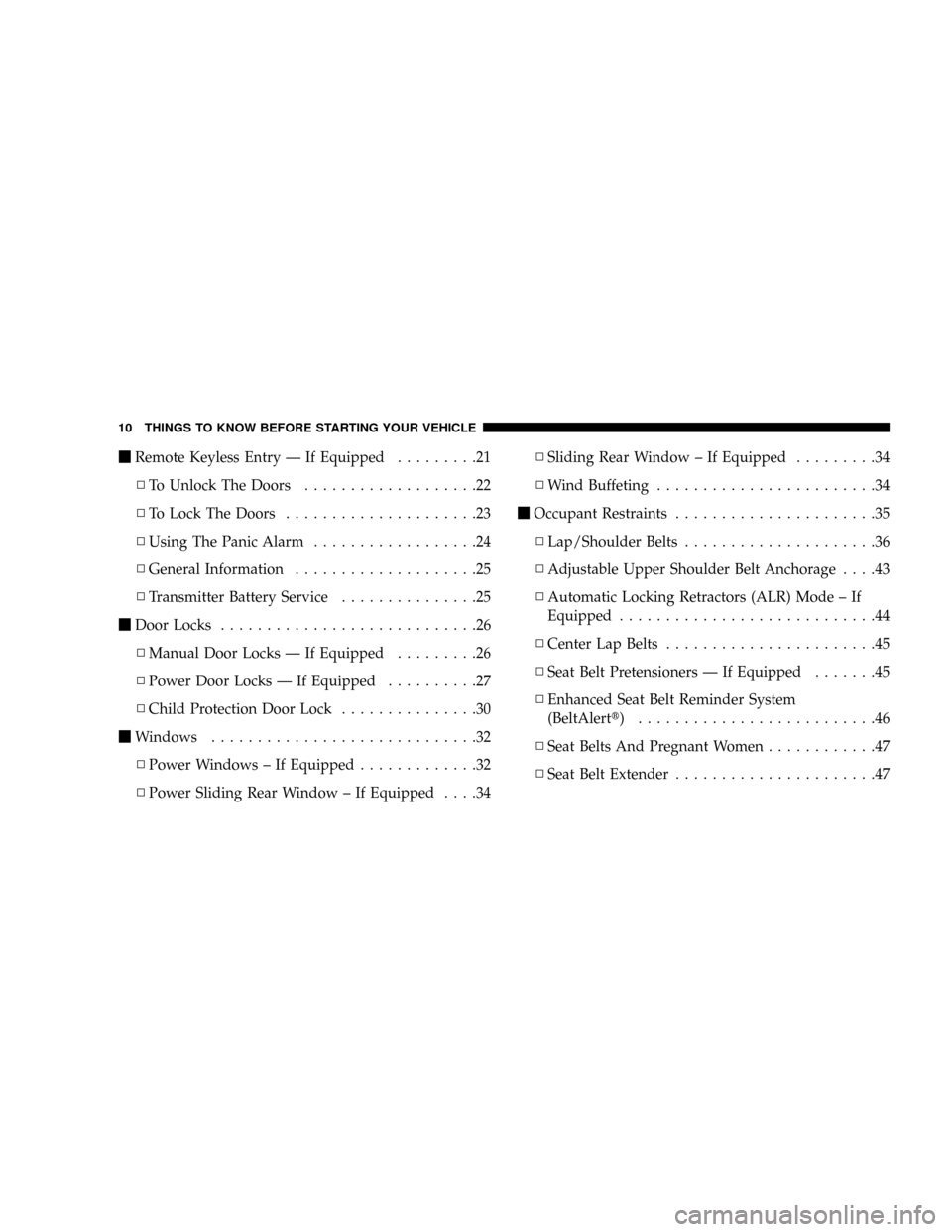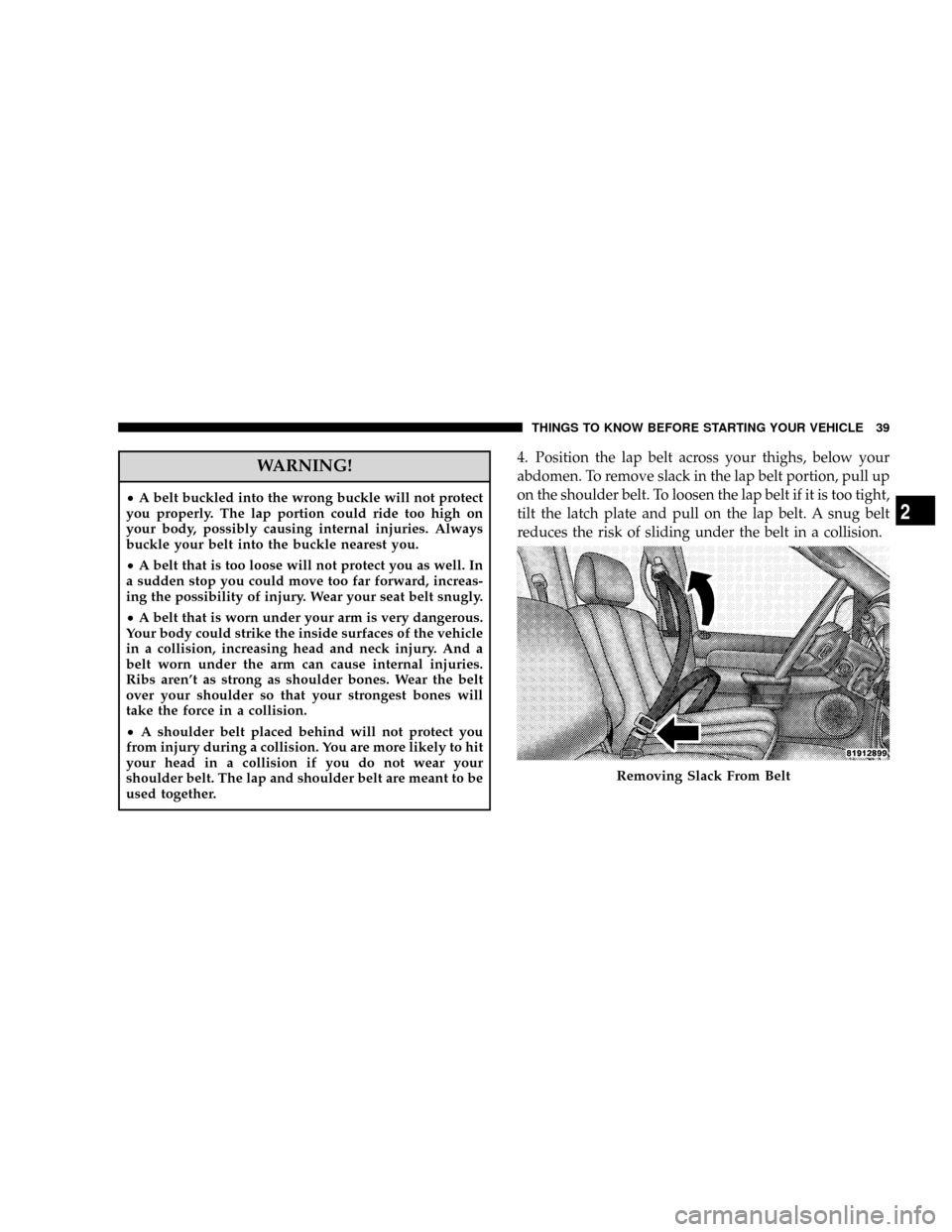Page 12 of 527

mRemote Keyless Entry Ð If Equipped.........21
NTo Unlock The Doors...................22
NTo Lock The Doors.....................23
NUsing The Panic Alarm..................24
NGeneral Information....................25
NTransmitter Battery Service...............25
mDoor Locks............................26
NManual Door Locks Ð If Equipped.........26
NPower Door Locks Ð If Equipped..........27
NChild Protection Door Lock...............30
mWindows.............................32
NPower Windows ± If Equipped.............32
NPower Sliding Rear Window ± If Equipped....34NSliding Rear Window ± If Equipped.........34
NWind Buffeting........................34
mOccupant Restraints......................35
NLap/Shoulder Belts.....................36
NAdjustable Upper Shoulder Belt Anchorage....43
NAutomatic Locking Retractors (ALR) Mode ± If
Equipped............................44
NCenter Lap Belts.......................45
NSeat Belt Pretensioners Ð If Equipped.......45
NEnhanced Seat Belt Reminder System
(BeltAlertt) ..........................46
NSeat Belts And Pregnant Women............47
NSeat Belt Extender......................47
10 THINGS TO KNOW BEFORE STARTING YOUR VEHICLE
Page 30 of 527

chime will sound if the key is in the ignition switch and
a door is open, as a reminder to remove the key.
Automatic Door Locks ± If Equipped
If this feature is enabled, your door locks will lock
automatically when the vehicle's speed exceeds 15 mph
(25 km/h).
Automatic Door Lock Programming
This feature is enabled when your vehicle is shipped
from the assembly plant and can be disabled by using the
following procedure:
²For vehicles equipped with the Electronic Vehicle
Information Center (EVIC), refer to ªPersonal Settings
(Customer Programmable Features)º under ªOver-
head Console with Electronic Vehicle Information
Center (EVIC) ± If Equippedº in Section 3.
²For vehicles not equipped with the EVIC, perform the
following procedure:1. Enter your vehicle and close all doors.
2. Fasten your seat belt. (Fastening the seat belt will
cancel any chiming that may confuse you during this
programming procedure.)
3. Place the key into the ignition.
4. Within 15 seconds cycle the key from the LOCK
position to the ON/RUN position a minimum of four
times, ending in the LOCK position(do not start the
engine).
5. Within 30 seconds, press the driver's door lock switch
in the LOCK direction.
6. A single chime will be heard to indicate the feature has
been disabled.
7. To reactivate this feature, repeat the above steps.
28 THINGS TO KNOW BEFORE STARTING YOUR VEHICLE
Page 31 of 527

8. If a chime is not heard, the program mode was
canceled before the feature could be disabled. If neces-
sary, repeat the above procedure.
Auto Unlock On Exit Ð If Equipped
This feature unlocks all of the doors of the vehicle when
any door is opened. This will occur only after the vehicle
has been shifted into the PARK position after the vehicle
has been driven (shifted out of PARK and all doors
closed).
Auto Unlock On Exit Programming Ð If Equipped
Customer programming sequence to enable or disable
the Auto Unlock Feature:
²For vehicles equipped with the Electronic Vehicle
Information Center (EVIC), refer to ªPersonal Settings
(Customer Programmable Features)º under ªOver-
head Console with Electronic Vehicle Information
Center (EVIC) ± If Equippedº in Section 3.
²For vehicles not equipped with the EVIC, perform the
following procedure:
1. Enter your vehicle and close all doors.
2. Fasten your seat belt. (fastening the seat belt will
cancel any chimes that may be confusing during this
programming procedure.)
3. Insert the key into the ignition.
4. Within 15 seconds, cycle the key from the LOCK
position to the ON/RUN position a minimum of four
times, ending in the LOCK position(do not start the
engine).
5. Within 30 seconds, press the driver's door lock switch
in the UNLOCK direction.
6. A single chime will sound to indicate the feature has
been changed.
THINGS TO KNOW BEFORE STARTING YOUR VEHICLE 29
2
Page 37 of 527

OCCUPANT RESTRAINTS
Some of the most important safety features in your
vehicle are the restraint systems. These include the front
and rear seat belts for the driver and all passengers, front
airbags for both the driver and front passenger and, if
equipped, window bags for the driver and passengers
seated next to a window. If you will be carrying children
too small for adult-size belts, your seat belts also can be
used to hold infant and child restraint systems.
Please pay close attention to the information in this
section. It tells you how to use your restraint system
properly to keep you and your passengers as safe as
possible.WARNING!
In a collision, you and your passengers can suffer
much greater injuries if you are not properly buckled
up. You can strike the interior of your vehicle or other
passengers, or you can be thrown out of the vehicle.
Always be sure you and others in your vehicle are
buckled up properly.
Buckle up even though you are an excellent driver, even
on short trips. Someone on the road may be a poor driver
and cause a collision that includes you. This can happen
far away from home or on your own street.
Research has shown that seat belts save lives, and that
they can reduce the seriousness of injuries in a collision.
Some of the worst injuries happen when people are
thrown from the vehicle. Seat belts reduce the possibility
THINGS TO KNOW BEFORE STARTING YOUR VEHICLE 35
2
Page 38 of 527

of ejection and the risk of injury caused by striking the
inside of the vehicle.Everyonein a motor vehicle should
be belted at all times.
Lap/Shoulder Belts
All seating positions except the Quad Cabtfront center
seating position have combination lap/shoulder belts.
The belt webbing retractor is designed to lock during
very sudden stops or collisions. This feature allows the
shoulder part of the belt to move freely with you under
normal conditions. But in a collision, the belt will lock
and reduce the risk of your striking the inside of the
vehicle or being thrown out.
WARNING!
It is extremely dangerous to ride in a cargo area,
inside or outside of a vehicle. In a collision, people
riding in these areas are more likely to be seriously
injured or killed.
Do not allow people to ride in any area of your
vehicle that is not equipped with seats and seat belts.
Be sure everyone in your vehicle is in a seat and
using a seat belt properly.
36 THINGS TO KNOW BEFORE STARTING YOUR VEHICLE
Page 39 of 527

WARNING!
²Wearing a seat belt incorrectly is dangerous. Seat
belts are designed to go around the large bones of
your body. These are the strongest parts of your
body and can take the forces of a collision the best.
Wearing your belt in the wrong place could make
your injuries in a collision much worse. You might
suffer internal injuries, or you could even slide out
of part of the belt. Follow these instructions to
wear your seat belt safely and to keep your pas-
sengers safe, too.
²Two people should never be belted into a single
seat belt. People belted together can crash into one
another in an accident, hurting one another badly.
Never use a lap/shoulder belt or a lap belt for more
than one person, no matter what their size.
Lap/Shoulder Belt Operating Instructions
1. Enter the vehicle and close the door. Sit back and
adjust the seat.
2. The seat belt latch plate is above the back of the front
seat, next to your arm in the rear seat. Grasp the latch
plate and pull out the belt. Slide the latch plate up the
webbing as far as necessary to allow the belt to go around
your lap.
THINGS TO KNOW BEFORE STARTING YOUR VEHICLE 37
2
Page 40 of 527
3. When the belt is extended long enough to fit, insert the
latch plate into the buckle until you hear a ªclick.º
1 Ð Latch Plate
Latch Plate To Buckle
38 THINGS TO KNOW BEFORE STARTING YOUR VEHICLE
Page 41 of 527

WARNING!
²A belt buckled into the wrong buckle will not protect
you properly. The lap portion could ride too high on
your body, possibly causing internal injuries. Always
buckle your belt into the buckle nearest you.
²A belt that is too loose will not protect you as well. In
a sudden stop you could move too far forward, increas-
ing the possibility of injury. Wear your seat belt snugly.
²A belt that is worn under your arm is very dangerous.
Your body could strike the inside surfaces of the vehicle
in a collision, increasing head and neck injury. And a
belt worn under the arm can cause internal injuries.
Ribs aren't as strong as shoulder bones. Wear the belt
over your shoulder so that your strongest bones will
take the force in a collision.
²A shoulder belt placed behind will not protect you
from injury during a collision. You are more likely to hit
your head in a collision if you do not wear your
shoulder belt. The lap and shoulder belt are meant to be
used together.
4. Position the lap belt across your thighs, below your
abdomen. To remove slack in the lap belt portion, pull up
on the shoulder belt. To loosen the lap belt if it is too tight,
tilt the latch plate and pull on the lap belt. A snug belt
reduces the risk of sliding under the belt in a collision.
Removing Slack From Belt
THINGS TO KNOW BEFORE STARTING YOUR VEHICLE 39
2